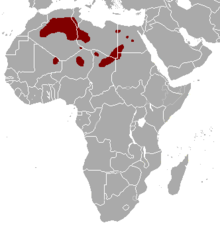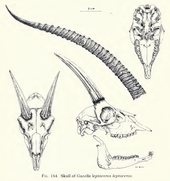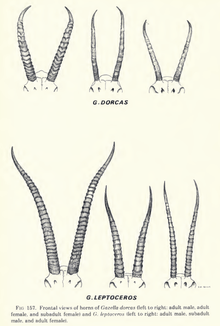Rhim gazelle
The rhim gazelle or rhim (Gazella leptoceros), also known as the slender-horned gazelle, sand gazelle or Loder's gazelle, is a pale-coated gazelle with long slender horns and well adapted to desert life. It is considered an endangered species because fewer than 2500 are left in the wild. These gazelles are found in Algeria, Chad, Egypt, Libya and Sudan.
| Rhim gazelle | |
|---|---|
.jpg) | |
| At the Cincinnati Zoo | |
| Scientific classification | |
| Kingdom: | Animalia |
| Phylum: | Chordata |
| Class: | Mammalia |
| Order: | Artiodactyla |
| Family: | Bovidae |
| Subfamily: | Antilopinae |
| Genus: | Gazella |
| Species: | G. leptoceros |
| Binomial name | |
| Gazella leptoceros (F. Cuvier, 1842) | |
| Subspecies | |
| |
 | |
| Distribution map | |
| Synonyms[2][3] | |
| |
Name
According to Richard Lydekker, the name rhim is Algerian Arabic, while in Tunisian and Egyptian the animal is known as the ghazal abiad, "white gazelle", owing to its pale coat. The name rhim is cognate with and perhaps derived from the Hebrew term re'em found in the Bible, which may refer to an aurochs, oryx or perhaps a unicorn.[4]
Although described and named by Frédéric Cuvier in 1842, the rhim gazelle was rediscovered by Edmund Giles Loder later in the same century, hence the synonym Gazella loderi and the common name Loder's gazelle.[4]
Description


Growing to a length of 101 to 116 cm (40 to 46 in), this is the palest of the gazelles, and well adapted to desert life in many ways. The upper parts are pale buff or cream and the limbs and under parts white or pale buff. The horns on the male are slender and slightly S-shaped; those of the female are even thinner, lighter and nearly straight. There are faint facial markings and an indistinct stripe along the side. The tail is brownish-black, about 15 cm (6 in) long, and contrasts with the pale rump.[5]
Distribution and habitat
The rhim gazelle is known from Algeria, Tunisia, Libya and Egypt. It has also been reported from Niger and Chad, but these sightings seem doubtful and its precise range is unclear. The rhim gazelle is found in isolated pockets across the central Sahara Desert. The extreme heat of this environment limits their feeding to the early morning and evening, and G. leptoceros gains most of its water requirements from dew and plant moisture, relying little on open water sources. The rhim gazelle is a nomadic species, moving across its desert range in search of vegetation, though it does not have a set migratory pattern. Its typical habitat is sand dunes and the depressions between them and other sandy areas, but also rocky areas.[5]
Status
Endangered by the early 1970s, this species of gazelle was in serious decline. They were hunted firstly by mounted then by motorized hunters for sport, meat, or their horns, which were sold as ornaments in North African markets. The threats the animals face now include poaching, disturbance by humans and loss of suitable habitat. The International Union for Conservation of Nature estimates there may only be 300 to 600 mature individuals in the wild, and has rated their conservation status as "endangered".[1]
In philately
On February 1, 1987, the Libyan General Posts and Telecommunications Company, in cooperation with World Wide Fund for Nature, issued a set of four postage stamps illustrating Gazella leptoceros.[6]
References
- Mallon, D.P.; Cuzin, F.; de Smet, K. & Hoffmann, M. (2008). "Gazella leptoceros". IUCN Red List of Threatened Species. 2008. Retrieved 22 August 2011.CS1 maint: ref=harv (link)
- Beudels, Roseline C.; Devillers, Pierre (2013). "Gazella leptoceros Slender-horned Gazelle (Rhim Gazelle, Loder's Gazelle)". In Kingdon, Jonathan; Hoffmann, Michael (eds.). Hippopotamuses, Pigs, Deer, Giraffe and Bovids. Mammals of Africa. 6. London: Bloomsbury. pp. 352–355.
- Grubb, P. (2005). "Order Artiodactyla". In Wilson, D.E.; Reeder, D.M (eds.). Mammal Species of the World: A Taxonomic and Geographic Reference (3rd ed.). Johns Hopkins University Press. pp. 681–682. ISBN 978-0-8018-8221-0. OCLC 62265494.
- Richard Lydekker (1908), The Game Animals of Africa, London: Rowland Ward, pp. 254–55.
- Richard Hoath (2009). A Field Guide to the Mammals of Egypt. American University in Cairo Press. pp. 153–154. ISBN 978-977-416-254-1.
- Libyan Stamps online Archived 2009-03-03 at the Wayback Machine
Further reading
- Devillers, Pierre; Lafontaine, René-Marie; Beudels-Jamer, Roseline C.; Devillers-Terschuren, Jean (2006). "Gazella leptoceros". In Beudels, R. C.; Devillers, P.; Lafontaine, R.-M.; Devillers-Terschuren, J.; Beudels, M.-O. (eds.). Sahelo-Saharan Antelopes: Status and Perspectives: Report on the conservation status of the six Sahelo-Saharan Antelopes (PDF). CMS Technical Series Publication. 10 (2nd ed.). Bonn: UNEP/CMS Secretariat. pp. 65–74.
- Mallon, D. P.; Kingswood, S. C., eds. (2001). North Africa, the Middle East, and Asia. Antelopes: Global Survey and Regional Action Plans. 4. Gland, Switzerland: IUCN. ISBN 2-8317-0594-0.
- Osborn, Dale J.; Helmy, Ibrahim (1980). "Gazella leptoceros (F. Cuvier, 1842)". The Contemporary Land Mammals of Egypt (Including Sinai). Fieldiana Zoology. New Series. 5. Chicago: Field Museum of Natural History. pp. 487–501.
